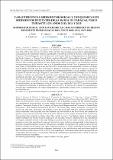Por favor, use este identificador para citar o enlazar este ítem:
https://hdl.handle.net/20.500.12958/6576Registro completo de metadatos
| Campo DC | Valor | Lengua/Idioma |
|---|---|---|
| dc.contributor.author | Solís Acosta, Juana | - |
| dc.contributor.author | Velazco Castillo, Federico | - |
| dc.contributor.author | Morón, O. | - |
| dc.contributor.author | Sánchez, S. | - |
| dc.contributor.author | Calderón, A. | - |
| dc.contributor.author | Fernández, J.C. | - |
| dc.contributor.author | Luciano, L. | - |
| dc.contributor.author | Vítor, J. | - |
| dc.date.accessioned | 2022-12-21T16:42:18Z | - |
| dc.date.available | 2022-12-21T16:42:18Z | - |
| dc.date.issued | 2022-12 | - |
| dc.identifier.citation | Solís, J., Velazco, F., Morón, O., Sánchez, S., Calderón, A., Fernández, J. C., Luciano, L., Vítor, J. (2022). Características sedimentológicas y geoquímicas de sedimentos recientes de la bahía de Paracas, Pisco, durante los años 2013, 2014 y 2015. Bol Inst Mar Perú. 37(2): 348-360. | es_ES |
| dc.identifier.issn | 04587766 | - |
| dc.identifier.uri | https://hdl.handle.net/20.500.12958/6576 | - |
| dc.description.abstract | Se presentan características sedimentológicas y geoquímicas de sedimentos marinos superficiales recientes de la bahía de Paracas, como parte de los Proyectos “Estudio Integrado de la Dinámica de los Procesos Físicos y Biogeoquímicos en Ecosistemas del Borde Costero” y “Fondo Para el Medio Ambiente Mundial”, desarrollados durante 2013, 2014 y 2015. Los sedimentos recientes de la bahía de Paracas corresponden a texturas limo arcilloso, arcilla limosa y limo arenoso, que están asociados a bajas intensidades de corrientes. Los sedimentos arenosos se registraron cerca de la línea de costa y de la desembocadura del río Pisco, la presencia de grava es muy escasa (<1%) hallada al norte del río Pisco. En la zona costera se incrementa la corriente y el oleaje, transportando material más fino hacia lugares donde la corriente es menor. Los mayores valores de materia orgánica total corresponden a fracción fina conformada por limo y arcilla, estando condicionada al aporte de material de origen biogénico relacionado a la alta productividad biológica en la columna de agua, y también por presencia de partículas muy finas de desechos urbanos e industriales, que se incorporan al fondo por procesos de transporte y sedimentación. La mayor variación se halló en la zona sur de la bahía entre la Puntilla y El Chaco, con valores que fluctuaron de 12,21 a 17,80%; mientras que los más bajos contenidos de materia orgánica total están asociados a sedimentos con dominio de la fracción arena y se encontraron al norte del río Pisco, con valores de 3,16 a 3,21%, que corresponden a evaluaciones realizadas en primavera 2014 e invierno 2015. El interior de la bahía es ocasionalmente afectado por contaminantes de origen antropogénico al presentarse vientos norte y circulación marina con dirección sur. | es_ES |
| dc.description.abstract | ABSTRACT: During 2013, 2014, and 2015, we analyzed the sedimentological and geochemical characteristics of recent marine surface sediments from Paracas Bay, as part of the projects “Integrated Study of the Dynamics of Physical and Biogeochemical Processes in Coastal Edge Ecosystems” and “Global Environment Facility”. At Paracas Bay, recent sediments correspond to clayey silt, silty clay, and sandy silt textures, which are associated with low current intensities. The sandy sediments were recorded near the coastline and the mouth of the Pisco River, the presence of gravel is very scarce (<1%) found north of the river. The current and waves increase in the coastal area, transporting finer material to places where the current is lower. The highest values of total organic matter correspond to the fine fraction made up of silt and clay, which is conditioned by the contribution of biogenic material related to the high biological productivity in the water column, and also by the presence of very fine particles of urban and industrial waste, which are incorporated to the bottom by transport and sedimentation processes. The greatest variation was found in the southern part of the bay between Puntilla and El Chaco, with values ranging from 12.21 to 17.80%; while the lowest total organic matter contents are associated with sediments dominated by the sand fraction and were found north of the Pisco River, with values of 3.16 to 3.21%, corresponding to evaluations conducted in spring 2014 and winter 2015. The inner bay is occasionally affected by anthropogenic pollutants due to north winds and southward marine circulation. | - |
| dc.language.iso | spa | es_ES |
| dc.publisher | Instituto del Mar del Perú | es_ES |
| dc.relation.ispartofseries | Boletín IMARPE 37(2), 2022; | - |
| dc.rights | info:eu-repo/semantics/openAccess | es_ES |
| dc.rights.uri | https://creativecommons.org/licenses/by/4.0/ | es_ES |
| dc.source | Instituto del Mar del Perú - IMARPE | es_ES |
| dc.source.uri | Repositorio Digital IMARPE | es_ES |
| dc.subject | Granulometría | es_ES |
| dc.subject | Biogénico | es_ES |
| dc.subject | Materia orgánica | es_ES |
| dc.subject | Limo | es_ES |
| dc.subject | Arcilla | es_ES |
| dc.subject | Grava | es_ES |
| dc.title | Características sedimentológicas y geoquímicas de sedimentos recientes de la bahía de Paracas, Pisco, durante los años 2013, 2014 y 2015 | es_ES |
| dc.title.alternative | Sedimentological and geochemical characteristics of recent sediments from Paracas Bay, Pisco (2013, 2014, and 2015) | es_ES |
| dc.type | info:eu-repo/semantics/article | es_ES |
| dc.publisher.country | Perú - Callao | es_ES |
| dc.subject.ocde | http://purl.org/pe-repo/ocde/ford#1.05.11 | es_ES |
| Aparece en las colecciones: | Boletín 37(2) 2022 | |
Ficheros en este ítem:
| Fichero | Descripción | Tamaño | Formato | |
|---|---|---|---|---|
| Boletin 37-2 artículo9.pdf | 897,34 kB | Adobe PDF |  Visualizar/Abrir |
Este ítem está sujeto a una licencia Creative Commons Licencia Creative Commons

